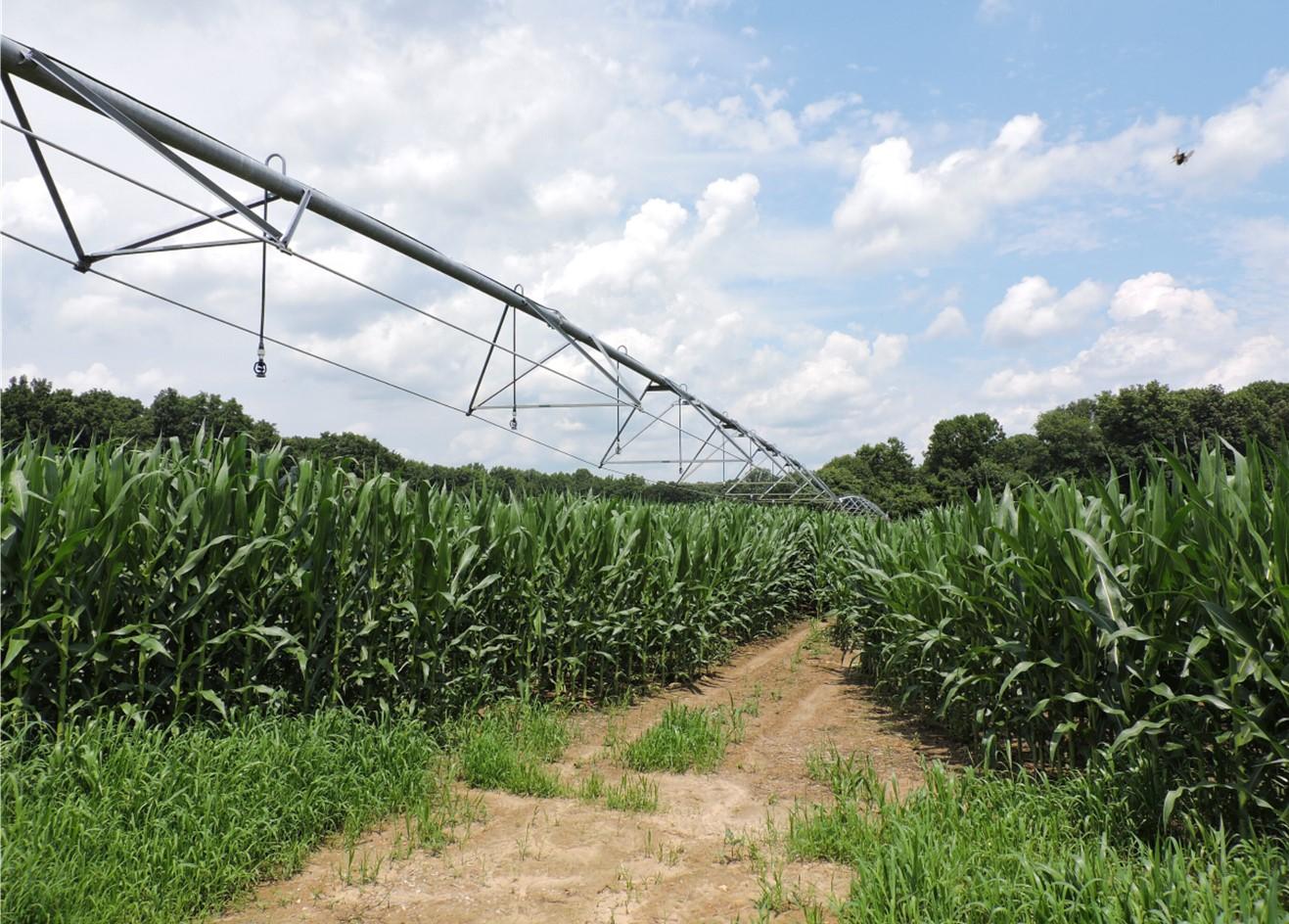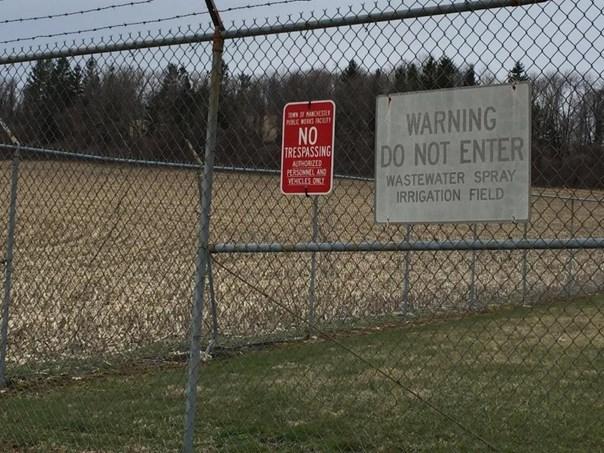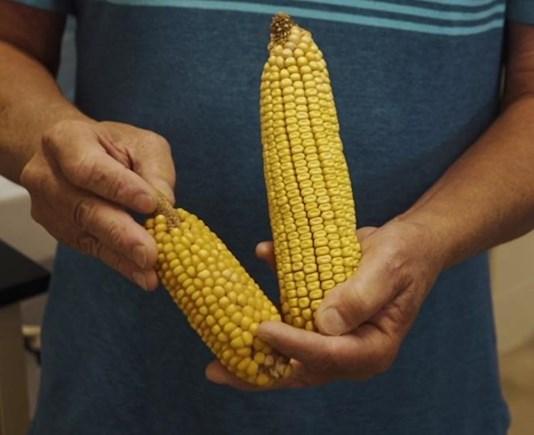
FS-1100 | April 2020
How Do I Use Reclaimed Water on My Farm? A Review of Maryland Class IV Reclaimed Water Guidelines
As the demand for water grows, the amount of water will remain the same, making it important to find new and reliable sources of water for agricultural production. One possibility is using highly treated effluent from municipal wastewater treatment plants, also known as reclaimed or recycled water. This guide is a review of the Maryland Department of Environment Guidelines for Use of Class IV Reclaimed Water: High Potential for Human Contact and what it means for farmers interested in using reclaimed water on their farm.

Farming operations rely on many inputs, including seeds, nutrients, soil amendments, and labor. Despite the enormous leaps in agricultural technologies, good yields fundamentally rely on natural resource inputs like sunlight, soil, and water. In Maryland, high-quality water resources have experienced different stressors in the last few decades, including excess precipitation alternating with periods of drought-like conditions, changes in groundwater availability, and increasing urbanization and demand for water for domestic uses.
As the demand for water grows, finding reliable sources of water for agricultural production is vital. One possibility is using highly treated effluent from municipal wastewater treatment plants, also known as reclaimed or recycled water. Using reclaimed water for a beneficial purpose is called water reuse.
Reclaimed water is used in agricultural production around the country. Twenty-nine percent of reclaimed water in the U.S. is used for agricultural irrigation (EPA, 2012). California, Idaho, and Florida are national leaders in water reuse for agriculture (Sheikh, Nelson, Haddad & Thebo, 2019).
This report is a review of the Maryland Department of Environment Guidelines for Use of Class IV Reclaimed Water: High Potential for Human Contact and what it means for farmers interested in using reclaimed water on their farm.
The Maryland Department of Environment (MDE) has created guidelines for water reuse, including use on certain agricultural crops. This guide addresses reuse of treated wastewater for a municipal wastewater treatment facility through reclaimed water systems. Note that using greywater (gently used water from bathroom sinks, showers, tubs, and washing machines) on site requires a sewage disposal permit from MDE and is not covered in this guide.
Reclaimed water systems in Maryland contain two main components: the treatment and distribution systems. The wastewater treatment plant is responsible for both systems. Treatment is the process of cleaning the wastewater the plant receives. Treatment includes the removal of solids, biological removal of dissolved solids and organics material, chemical treatments, and disinfection. The distribution system is how the treated water gets from the plant to the end user, often including storage facilities and piping infrastructure. The end user of agricultural water reuse is the farmer whose fields are being irrigated with reclaimed water.
In a way, all water is ‘reused’ in the water cycle. Surface water and groundwater used in agriculture come from rainfall that replenishes underground aquifers and surface water bodies. Treated effluent, in contrast, comes from an upstream wastewater treatment plant. Reusing treated water from wastewater plants for a specific purpose reduces energy needed for additional treatment and possible contamination from the environment. Instead of treated water being released into a stream or river where it could pick up environmental contaminants from animal feces or sediment, then flowing to an accessible point near the farm, and finally being pumped or otherwise collected by a farmer, the reclaimed water is sent directly to the farm where it is needed. Reusing municipal effluent can also provide a reliable source of water for Maryland farmers facing changes in water resources.
The Maryland Department of Environment defines reclaimed water as municipal effluent that has been treated to a high enough degree that it can be used for a beneficial purpose (Maryland Department of the Environment, 2016). Beneficial use is supplying water where it is needed in an economy or a community. Examples of beneficial use include cooling buildings, industrial processing, creating parks or other public spaces, and of course, agricultural irrigation (WateReuse, 2019; EPA, 2018).
In Maryland, there are four classes of reclaimed water: Class I, II, III, and IV. The classes have increasing levels of treatment and quality standards. The acceptable uses for the different classes of water vary based on how likely it is that humans will be exposed to the reclaimed water.
This report focuses on Class IV reclaimed water. It is the most highly treated of the Maryland reclaimed water classes, so it meets strict water quality standards, which is why it can be used for activities with higher potential for human contact.
As of 2019, Class IV reclaimed water is approved for agricultural irrigation for:
- Fiber and seed crops;
- Food crops that are chemically and/or physically processed before sale to ensure that potential pathogens have been destroyed or removed;
- Non-food crops;
- Pasture for foraging livestock;
- Turf, including fodder; and
- Forested land, golf courses, silviculture, sod farms and ornamental nurseries.
The wastewater treatment plant, not the end user, is responsible for all the water quality standards, construction and design specifications, monitoring, reporting, recordkeeping, and public education requirements (Table 1). The end user (farmer) is the recipient of a service.
| Responsible Party | ||
|---|---|---|
| Requirements for Class IV Reclaimed Water Use | Wastewater Treatment Plant | End user/farmer |
| Design specifications for the system, construction | X | |
| Request for applying water | X | |
| Water quality monitoring and compliance | X | |
| Record keeping | X | |
| Reporting to Maryland Department of Environment | X | |
The permits to build and operate the reclaimed water distribution system to the farm are issued to the wastewater treatment plant. The plant is responsible for handling all permit requirements and reporting to MDE. A written contract between the plant and the end user must be in place for distribution of reclaimed water to occur. The terms for those written contracts will include the plans for reclaimed water application which must be designed in conjunction with the farmer’s nutrient management plan, that include signage/notification, buffer zones, human contact and potable water avoidance, and prohibitions on uses. Each agreement will define these responsibilities differently and uniquely for each situation.
Some of the monitoring and operating requirements mean that the wastewater treatment plant operator has to communicate with the farmer regularly. Some monitoring may occur on the farm, but the operators of the wastewater treatment plant are ultimately responsible for making sure the entire system is in compliance.
The wastewater treatment plant measures water quality based on several parameters:
- Biochemical oxygen demand
- Turbidity/suspended solids
- E. coli and fecal coliform
- pH
- Total nitrogen
- Total chlorine residue
Table 2 lists more information about these parameters, including definitions.
It should be noted that the Class IV pathogen limitation (E. coli 1MPN/100ml) is more stringent than the 126 CFU/100ml E. coli agricultural water quality standard included in the federal Food and Drug Administration Produce Safety Rule (PSR) (C. Tien, personal communication, April 16, 2019).
The wastewater treatment plant is responsible for ensuring that the reclaimed water meets all standards throughout the system, including near the point of use. If one or more of the parameters is above or below the required level, the plant is required to take corrective action. A key component of any corrective action plan is to inform the end user of the issue and possible responses, including potentially cutting off the water supply until the problem is resolved. This is one example of a type of communication a farmer may receive from the facility operator. The wastewater treatment plant is required to submit detailed water quality reports to MDE on a monthly and yearly basis.
| Parameterᵃ | Class IV Water Quality Requirements |
Comparison with Requirements for Other Existing Classes Class Ib Class II |
||
|---|---|---|---|---|
| Class Ib | Class II | Class III | ||
| Biochemical Oxygen Demandᶜ (monthly average) |
10 mg/l | 70 mg/l | 10 mg/l | 10 mg/l |
| Turbidity/ Suspended Solids (general water quality indicator) |
2 NTUᵈ (daily average) CAT >5 NTUᵈ (at any time) |
90 mg/l (monthly average) |
10 mg/l (monthly average) |
2 NTUᵈ (daily average) Not to exceed 5 NTUᵈ at any time |
| E.coliᵉ (monthly median)ᶠ |
1 MPNᵍ/10 0 mlor meeting the fecal coliform limit below |
N/A* | N/A* | N/A* |
| Fecal Coliform (fecal indicator)ʰ |
2.2 MPNᵍ/10 0 ml (monthly median)ᶠ |
200 MPNᵍ/100 ml(monthly geometric mean)i or 3 MPNᵍ/100 ml(monthly geometric mean)ⁱ for use on golf courses |
3 MPNᵍ/100 ml (monthly geometric mean)ᵍ |
2.2 MPNᵍ/100 ml (monthly geometric mean)ⁱ |
| pHʲ (any time) | 6.5-8.5 s.u.ᵏ |
6.5 -8.5 s.u.ᵏ | 6.5-8.5 s.u.ᵏ | 6.5-8.5 s.u.ᵏ |
| Total Nitrogen (monthly average) |
10 mg/l | case by caseˡ | case by caseˡ | case by caseˡ |
| Total Residual Chlorineᵐ (measured at the treatment system outlet) |
1.5 –4.0 mg/l(any time) |
N/A* | N/A* | N/A* |
| Total Residual Chlorineᵐ (measured at designated sampling locations in the distribution system)ⁿ |
0.5 –4.0 mg/l(any time) |
N/A* | N/A* | N/A* |
| Adapted from Maryland Department of Environment Guidelines for Use of Class IV Reclaimed Water: High Potential for Human Contact *N/A or “not applicable” means there is no standard for that parameter for the class of reclaimed water indicated. a) Class I, II, and III parameters (not including E. coli) were taken from Guidelines for Land Application/Reuse of Treated Municipal Wastewaters (MDE-WMA-001-04/10). Levels equivalent to the fecal coliform requirements are the basis of the requirements for E. coli. b) Class I water quality requirements do not meet the definitions of reclaimed water under § 9-301 of the Annotated Code of Maryland. c) Biological Oxygen Demand (BOD5 or CBOD5) means the quantity of oxygen utilized in the biochemical oxidation of organic matter present in water or wastewater, reported as a five-day value determined using approved laboratory methods. d) Nephelometric Turbidity Unit (NTU) is a ratio of the intensity of light scattered by the sample to the intensity of incident light, as determined using approved laboratory methods. e) Escherichia coli (E. coli) is a type of bacteria that live in the intestines of warm-blooded animals and humans. Most E. coli are harmless but some are pathogenic, meaning they can cause illness in humans (CDC “Escherichia”, 2014). f) Median is defined as the mean of the two middle values from an even number of monthly samples. g) Most Probable Number (MPN) is a statistical value representing the viable bacterial population in a sample identified through the use of dilution and multiple tube inoculations. h) Fecal coliform is a type of bacteria that live in feces, but not all cause illness in humans. Fecal coliform is called a fecal indicator, because its presence means the water supply has been contaminated by an outside source (EPA, 2012). i) Geometric mean is a value derived from a set of numbers by using the product of their values, expressed as the nth root of the product of n numbers (i.e., the geometric mean of 2 and 8 is the square root of their product (16) which = 4; if multiplying a set of 3 numbers, then geometric mean = the cubed root of the product of the 3 numbers, and so on). j) pH means the negative common logarithm of hydrogen ion activity determined using approved laboratory methods. k) Standard unit of deviation |
||||
The end-user agreement is a contract made with input from both the farmer and the wastewater treatment plant. It is like any other service agreement with a vendor, such as a commercial applicator or equipment leasing. The distribution portion of the reclaimed water system will be tailored to the needs of the field site or sites. Creating an agreement will likely require meetings and regular communication between the farmer and the plant operators during the initial stages of the relationship.
The end-user agreement will also designate responsibilities and liability. If there is a water quality issue, the designated responsible party in the agreement, typically the wastewater treatment plant, is liable (C. Tien, personal communication, April 16, 2019). The wastewater treatment plant is also responsible for making sure signage, notifications, and all plans for application are submitted to and approved by MDE. The end-user agreement includes expectations for the farmer. For example, it is expected that the farmer will:
- distribute the reclaimed water evenly, as appropriate, to prevent ponding and runoff;
- prevent aerosolization, primarily by using low-trajectory overhead nozzles or drip irrigation; and
- not allow reclaimed water to leave the site. In other words, a neighbor cannot come by and hook their hose up to the system.
The key component of the end-user agreement is the buffer zone. The wastewater treatment plant needs to know if and where any potable water sources or springs are on the property. These potable water sources require a 50- to 100-foot buffer zone from application of reclaimed water. The goal of this buffer zone is to prevent reclaimed water from getting into the drinking water supply. A buffer zone is also required near outdoor eating, drinking, and bathing locations, unless the reclaimed water is applied using low-trajectory spray irrigation or drip irrigation. This second type of buffer zone likely will only be an issue if the farm operation also has an agritourism operation. The end-user agreement also details the prohibitions for using reclaimed water. The reclaimed water cannot be:
- applied when the water table is elevated. The wastewater treatment plant will likely install groundwater level monitors to ensure the field is not being sprayed when the groundwater table is less than two feet from the surface (Maryland Department of the Environment, 2016);
- applied when the soils are saturated or frozen or applied to bare ground that is not germinating seed. The assumption is that irrigated fields will have a healthy vegetative cover; and
- applied during persistent rainfall, because irrigating during rainfall increases the chances of surface runoff and ponding in the field.
The MDE guidelines do not have season-based restrictions on when Class IV reclaimed water can be applied to fields. However, Maryland Department of Agriculture (MDA) prohibits winter application of wastewater-containing nutrients onto agricultural land, with limited exceptions. Application restrictions are available from MDA’s Maryland Nutrient Management Manual.
If the farm is a Maryland Agricultural Land Preservation (MALP) site, using reclaimed water on the property may require an additional agreement between the farmer and the MALP Foundation (MALPF). This agreement is to ensure the soil on the property will not be damaged by irrigating with reclaimed water. For more information about farming with easements, please see Agricultural Leasing Guide and How to Lease Your Land with a Conservation Easement.
The most important communication occurs when the farmer notifies the treatment plant that the fields need water. In an interview, a wastewater plant manager noted that the farmer using his plant’s reclaimed water decides when the water is applied. The plant manager credits the success of the partnership to this flexibility (G. Swartz, October 23, 2019).
The wastewater treatment plant may install monitoring equipment or conduct water sampling in or near a field which will help the plant and farmer track water usage and quality. Plant operators cannot enter the farm property without permission but may need to complete monitoring activities monthly while the farmer is using reclaimed water. The end user agreement should detail these monitoring, testing, and maintenance rights and responsibilities.

The plant is also required to post signage that reclaimed water is being used (Figure 1). The plant is responsible for creating and maintaining these signs, but they may be close to or on the farm field.
As development is continually occurring in Maryland, many farms are now neighbors with homeowners, instead of other farmers. These neighbors may have concerns when they see MDE signage indicating reclaimed water is being used for irrigation. In this case, clear communication between the wastewater treatment the farmer, and the concerned neighbors is a good strategy for reducing tensions

A key point in the MDE guideline is the plant is responsible for maintaining and monitoring the water treatment and distribution systems, including the water quality. If they find issues, such as water that does not meet regulatory standards, they may need to cut off the water supply to the farm. This is a potential issue if it occurs when there is high demand for water for crops. In this case, the plant is required to notify the farm operator that they cannot supply water for a certain time period, likely between several hours to two days (Maryland Department of the Environment, 2016). Unlike the unpredictable nature of rainfall, the wastewater treatment plant operates daily so it can supply a relatively steady supply of water during the growing season. This can help farmers protect themselves from the impacts of drought. Additionally, farmers will have assurance that the water quality meets state and federal standards due to almost constant monitoring by the plant.
Beyond the immediate benefits to production and yields, using Class IV reclaimed water conserves ground and surface water sources. Farmers with limited water resources on the farm may save on pumping costs. Farmers with depleting water resources may be able to supplement or even replace those sources with reclaimed water.
- Centers for Disease Control and Prevention (CDC). (2014). Chlorine Residual Testing. Retrieved from https://www.cdc.gov/safewater/chlorine-residual-testing.html
- Centers for Disease Control and Prevention (CDC). (2014). E. coli (Escherichia coli). Retrieved from: https://www.cdc.gov/ecoli/general/index.html
- Maryland Department of the Environment. (2016). Guidelines for Use of Class IV Reclaimed Water: High Potential for Human Contact (MDE-WMA-002-07/15). Baltimore, MD.
- Sheikh, B., Nelson, K. L., Haddad, B., & Thebo, A. (2019). Grey Water: Agricultural Use of Reclaimed Water in California. Journal of Contemporary Water Research & Education, 165(1), 28-41.
- U.S Environmental Protection Agency (EPA). (2012). Water Monitoring & Assessment: 5.11 Fecal Bacteria. Retrieved from:https://archive.epa.gov/water/archive/web/html/vms511.html
- U.S. Environmental Protection Agency/Office of Wastewater Management (EPA). (2012). 2012 Guidelines for Water Reuse. (EPA/600/R-12/618). Washington, D.C.
- U.S Environmental Protection Agency (EPA). (2018). Water Reuse and Recycling: Community and Environmental Benefits. (EPA 909-F-98-001). San Francisco, CA.
- WateReuse Association. (2019). Water Reuse Glossary. Retrieved from: https://watereuse.org/educate/water-reuse-101/glossary/
Overall, reclaimed water can be a relatively reliable, safe water source that can increase production yields and longevity of the operation. While experiencing those benefits, farmers are also continuing their long-standing role as stewards of natural resources and ensuring those resources last for generations to come.
CONSERVE: A Center of Excellence at the Nexus of Sustainable Water Reuse, Food and Health was awarded to the University of Maryland School of Public Health by the United States Department of Agriculture-National Institute of Food and Agriculture, Grant number 20166800725064
For more information about recycled water in agriculture, including case studies, fact sheets and videos, visit www.conservewaterforfood.org




MAYHAH SURI*
msuri1@umd.edu
PAUL GOERINGER*
lgoering@umd.edu
DR. RACHEL ROSENBERG GOLDSTEIN*+
rerosenb@umd.edu
* University of Maryland, College of Agriculture & Natural Resources and the Department of Agricultural Resource Economics
+ University of Maryland, School of Public Health, Maryland Institute for Applied Environmental Health
This publication, How Do I Use Reclaimed Water on My Farm? A Review of Maryland Class IV Reclaimed Water Guidelines (FS-1100) is part of a collection produced by the University of Maryland Extension within the College of Agriculture and Natural Resources.
The information presented has met UME peer-review standards, including internal and external technical review. For help accessing this or any UME publication contact: itaccessibility@umd.edu
For more information on this and other topics, visit the University of Maryland Extension website at extension.umd.edu
University programs, activities, and facilities are available to all without regard to race, color, sex, gender identity or expression, sexual orientation, marital status, age, national origin, political affiliation, physical or mental disability, religion, protected veteran status, genetic information, personal appearance, or any other legally protected class.
 English
English العربية
العربية Български
Български 简体中文
简体中文 繁體中文
繁體中文 Hrvatski
Hrvatski Čeština
Čeština Dansk
Dansk Nederlands
Nederlands Suomi
Suomi Français
Français Deutsch
Deutsch Ελληνικά
Ελληνικά हिन्दी
हिन्दी Italiano
Italiano 日本語
日本語 한국어
한국어 Norsk bokmål
Norsk bokmål Polski
Polski Português
Português Română
Română Русский
Русский Español
Español Svenska
Svenska Català
Català Filipino
Filipino עִבְרִית
עִבְרִית Bahasa Indonesia
Bahasa Indonesia Latviešu valoda
Latviešu valoda Lietuvių kalba
Lietuvių kalba Српски језик
Српски језик Slovenčina
Slovenčina Slovenščina
Slovenščina Українська
Українська Tiếng Việt
Tiếng Việt Shqip
Shqip Eesti
Eesti Galego
Galego Magyar
Magyar Maltese
Maltese ไทย
ไทย Türkçe
Türkçe فارسی
فارسی Afrikaans
Afrikaans Bahasa Melayu
Bahasa Melayu Kiswahili
Kiswahili Gaeilge
Gaeilge Cymraeg
Cymraeg Беларуская мова
Беларуская мова Íslenska
Íslenska Македонски јазик
Македонски јазик יידיש
יידיש Հայերեն
Հայերեն Azərbaycan dili
Azərbaycan dili Euskara
Euskara ქართული
ქართული Kreyol ayisyen
Kreyol ayisyen اردو
اردو বাংলা
বাংলা Bosanski
Bosanski Cebuano
Cebuano Esperanto
Esperanto ગુજરાતી
ગુજરાતી Harshen Hausa
Harshen Hausa Hmong
Hmong Igbo
Igbo Basa Jawa
Basa Jawa ಕನ್ನಡ
ಕನ್ನಡ ភាសាខ្មែរ
ភាសាខ្មែរ ພາສາລາວ
ພາສາລາວ Latin
Latin Te Reo Māori
Te Reo Māori मराठी
मराठी Монгол
Монгол नेपाली
नेपाली ਪੰਜਾਬੀ
ਪੰਜਾਬੀ Afsoomaali
Afsoomaali தமிழ்
தமிழ் తెలుగు
తెలుగు Yorùbá
Yorùbá Zulu
Zulu ဗမာစာ
ဗမာစာ Chichewa
Chichewa Қазақ тілі
Қазақ тілі Malagasy
Malagasy മലയാളം
മലയാളം සිංහල
සිංහල Sesotho
Sesotho Basa Sunda
Basa Sunda Тоҷикӣ
Тоҷикӣ O‘zbekcha
O‘zbekcha አማርኛ
አማርኛ Corsu
Corsu Ōlelo Hawaiʻi
Ōlelo Hawaiʻi كوردی
كوردی Кыргызча
Кыргызча Lëtzebuergesch
Lëtzebuergesch پښتو
پښتو Samoan
Samoan Gàidhlig
Gàidhlig Shona
Shona سنڌي
سنڌي Frysk
Frysk isiXhosa
isiXhosa